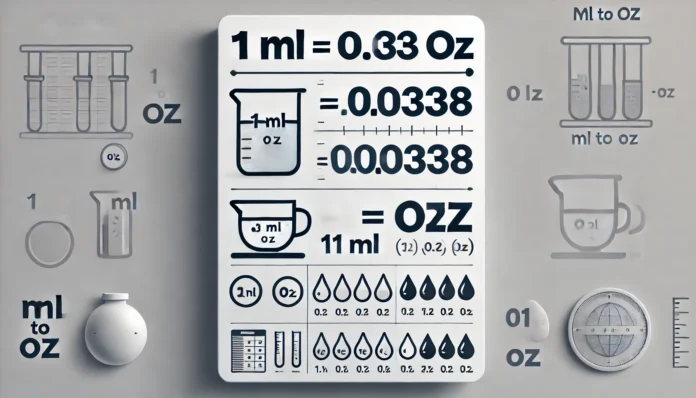Converting milliliters (ml) to ounces (oz) is essential for cooking, baking, and understanding liquid measurements. Whether you’re dealing with 750 ml to oz, 500 ml to oz, or even 1 oz to ml, knowing the conversion can be incredibly useful.
Understanding ML to OZ Conversion
Milliliters (ml) and ounces (oz) are common volume measurement units. While milliliters are widely used in the metric system, ounces are primarily used in the imperial system, especially in the United States.
How to Convert ML to OZ
The conversion formula is:
1 ml = 0.033814 oz
To convert milliliters to ounces, simply multiply the ml value by 0.033814.
For example:
- 750 ml to oz = 750 × 0.033814 = 25.36 oz
- 500 ml to oz = 500 × 0.033814 = 16.91 oz
- 250 ml to oz = 250 × 0.033814 = 8.45 oz
Common Conversions from OZ to ML
To convert ounces to milliliters, use the formula:
1 oz = 29.5735 ml
Examples:
- 1 oz to ml = 1 × 29.5735 = 29.57 ml
- 12 oz to ml = 12 × 29.5735 = 354.88 ml
- 16 oz to ml = 16 × 29.5735 = 473.18 ml
Why is ML to OZ Conversion Important?
Understanding ml to oz conversion is helpful in multiple scenarios, such as:
- Cooking and Baking: Many recipes list ingredients in different measurement systems.
- Beverage Measurements: Wine, soda, and bottled water are often labeled in milliliters.
- Health & Nutrition: Liquid medications and supplements often require precise measurement.
ML to OZ Conversion Chart
For quick reference, here’s a handy conversion chart:
| Milliliters (ml) | Ounces (oz) |
|---|---|
| 50 ml | 1.69 oz |
| 100 ml | 3.38 oz |
| 250 ml | 8.45 oz |
| 500 ml | 16.91 oz |
| 750 ml | 25.36 oz |
| 1000 ml (1 L) | 33.81 oz |
Frequently Asked Questions
How Many Ounces are in a Cup?
A standard US cup holds 8 ounces (oz) or approximately 237 ml.
How Many ML is in 1 OZ?
One fluid ounce (oz) is equivalent to 29.5735 ml.
Is There a Difference Between US and UK Fluid Ounces?
Yes! The US fluid ounce is 29.5735 ml, whereas the UK (Imperial) fluid ounce is 28.4131 ml.
How Accurate are Online ML to OZ Converters?
Most online converters provide accurate results, but it’s always best to understand the basic conversion formulas.
Detailed Breakdown of ML to OZ for Different Scenarios
Cooking and Baking Measurements
When following a recipe, precise measurements are crucial. Many European and Asian recipes use milliliters, whereas American recipes often use ounces and cups. Converting these measurements correctly ensures accuracy and consistency in cooking.
For example:
- A typical coffee mug holds around 350 ml (11.83 oz)
- A small soup bowl can hold approximately 500 ml (16.91 oz)
- A full glass of water is usually 250 ml (8.45 oz)
Beverages and Alcoholic Drinks
Liquids like soda, juice, and alcoholic beverages are commonly labeled in milliliters, but knowing the ounce equivalent can be helpful.
Here are some common beverage conversions:
- 750 ml (Standard Wine Bottle) = 25.36 oz
- 355 ml (Soda Can) = 12 oz
- 500 ml (Medium Water Bottle) = 16.91 oz
- 1 Liter of Water = 33.81 oz
Health and Medical Uses
Medications, supplements, and liquid prescriptions are often measured in milliliters. A doctor may prescribe a dosage in ml, but some medicine cups display ounces.
For instance:
- A typical dose of liquid cough medicine is 10 ml (0.34 oz)
- A children’s medicine dropper usually holds 5 ml (0.17 oz)
Sports and Fitness
Many athletes monitor their water intake in milliliters. Water bottles typically list capacity in ml, while sports guides often recommend daily intake in ounces.
For instance:
- A sports water bottle may contain 750 ml (25.36 oz)
- Recommended daily intake for an adult is around 2,000-3,000 ml (67-101 oz)
Fun Facts About ML and OZ
- The ounce (oz) originated from the Roman measurement system, with the term derived from the Latin word “uncia.”
- The milliliter (ml) is a relatively modern measurement introduced with the metric system.
- Most perfumes and colognes are measured in ml rather than oz, with common sizes being 50 ml (1.69 oz) or 100 ml (3.38 oz).
Conclusion
Whether you’re measuring liquids for a recipe, a beverage, or medication, knowing how to convert ml to oz (and vice versa) is incredibly useful. This guide provides all the necessary formulas, charts, and explanations to help you with ml to oz conversions. Bookmark this guide for quick conversions, and never be confused by milliliters and ounces again!

